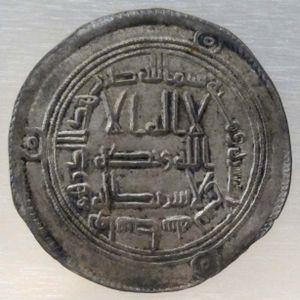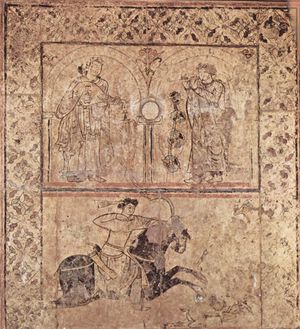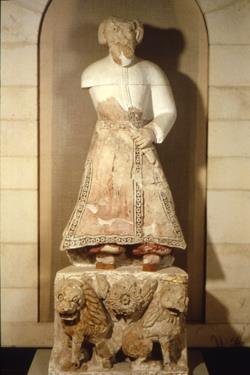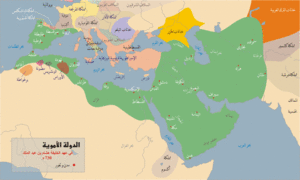هشام بن عبد الملك
| Hisham ibn Abd al-Malik هِشَام ابْن عَبْد الْمَلِك | |||||
|---|---|---|---|---|---|
 عملة صكها هشام بن عبد الملك | |||||
| خليفة الأسرة الأموية العاشر | |||||
| العهد | 691 (72 هـ) – 6 فبراير 743 | ||||
| سبقه | يزيد الثاني | ||||
| تبعه | الوليد الثاني | ||||
| وُلِد | 691 دمشق، سوريا، الخلافة الأموية | ||||
| توفي | 6 فبراير 743 (العمر 52 عامًا) (6 ربيع الثاني 125 هجرية) دمشق، سوريا، الخلافة الأموية | ||||
| الزوج |
| ||||
| الأنجال |
| ||||
| |||||
| الأسرة المالكة | الأموية | ||||
| الأب | عبد الملك | ||||
| الأم | عائشة بنت هشام المخزومي | ||||
| الديانة | الإسلام | ||||
هشام بن عبد الملك (و. 691 ت. فبراير 743)، هو الخليفة الأموي العاشر. حكم من عام 723 حتى وفاته عام 743م. عندما ولد عام 691 أسمته أمه على اسم أبيها.
السنوات المبكرة
ولد هشام بن عبد الملك في دمشق، عاصمة الخلافة الأموية، عام 72 هـ (691-692 ميلادي). والده هو الخليفة الأموي عبد الملك(ح. 685–705). وأمه عائشة بنت هشام بن إسماعيل من بنو مخزوم وهي عشيرة بارزة من قريش، وكان عبد الملك لفترة طويلة والياً على مكة والمدينة المنورة.[1][أ] وفقًا لتاريخ الطبري (توفي 923)، أُعطي لهشام كنية أبو الوليد.[3]
ولا يوجد الكثير من المعلومات عنطفولة وشباب هشام، لأنه كان أصغر من أن يلعب أي دور سياسي أو عسكري في عهد والده. فيما تقول بعض المصادر أنه قاد رحلة الحج إلى مكة مرة واحدة في عهد أخيه الوليد الأول (ح. 705–715) وأثناء وجوده التقى بسليل الخليفة والإمام علي بن أبي طالب(ح. 656–661)، زين العابدين بن الحسين.[2] ويقول الطبري أن هشام قاد حملة فتوحات ضد البيزنطيين عبر حدود الخلافة في عام 706، وسيطر على عدد من مواقعهم المحصنة.[4]
بدأ هشام في إظهار تطلعاته للخلافة عند وفاة أخيه سليمان عام 717. وكان سليمان على فراش الموت قد رشح ابن عمهما الأول عمر بن عبد العزيز لكنه أبقى الأمر سراً. وأوكل إبلاغ الوصية إلى كبير مستشاريه رجاء بن حيوة. وعندما أبلغ الرجاء العائلة الأموية بقرار الخلافة، احتج هشام على أن المنصب كان حكراً على أحفاد عبد الملك المباشرين ولم يتراجع عن معارضته إلا عندما هُدد باستخدام القوة.[5] ولم يلعب أي دور سياسي أو عسكري في عهد عمر (ح. 717–720) ولكن ورد ذكره في سيرة الأخير في القرن العاشر على أنه أصدر رسالة إلى الخليفة يشكو فيها من الطريقة التييعامل بها هو وإخوته في ظل حكم عمر. كما لم يشغل هشام أي منصب تحت قيادة أخيه يزيد بن عبد الملك (ح. 720–724)، خليفة عمر.[6]
خلافته
. في عهده بلغت الدولة الإسلامية أقصى اتساعها، حارب البيزنطيين واستولت جيوشه على ناربونه وبلغت أبواب بواتيه (فرنسا) حيث وقعت معركة بلاط الشهداء. حكم هشام (724-743) الدولة سبعة عشر عاماً حكماً عادلاً سادت فيه السلم، وأصلح في خلاله الشؤون الإدارية، وخفض الضرائب، وترك بيت المال بعد وفاته مليئاً بالأموال. ولكن لعل فضائل الزهد كانت سبباً في القضاء على الحاكم: فقد منيت جيوش هشام بعدة هزائم، وثار نقع الفتنة في الولايات، وعم الاستياء دمشق.
توليه العرش
بناءً على نصيحة أخيهم القائد العام مسلمة الأول، رشح يزيد هشام خلفًا له على ابنه الوليد الثاني، الذي كان ينوي في الأصل تعيينه الأول في الصف. انضم هشام بعد وفاة يزيد في يناير 724.[7] وتلقى الخبر أثناء تواجده في أرضه الصحراوية السورية الزيتونة المعروفة بـ قصر الحير الغربي بالقرب من الرصافة.[8] تم تحديده على أنه مكان إقامة هشام المفضل والمعروف اليوم باسم قصر الحير الشرقي. وقد أعطاه رسول البريد خاتم الخلافة وعصاه، ثم ركب بعد ذلك إلى دمشق،[3] حيث تم نصبه خليفةً علنياً.[9]
نظرة عامة
لقد ورث هشام إمبراطورية تعاني من العديد من المشاكل المختلفة. ومع ذلك، سيكون فعالاً في معالجة هذه المشاكل، وفي السماح للإمبراطورية الأموية بالاستمرار ككيان. كان حكمه الطويل فعالاً، وشهد ولادة جديدة للإصلاحات التي بدأها عمر بن عبد العزيز.
مثل الوليد الأول، كان هشام راعيًا عظيمًا للفنون، وقد شجع الفنون مرة أخرى في الإمبراطورية. كما شجع نمو التعليم من خلال بناء المزيد من المدارس، وربما الأهم من ذلك، من خلال الإشراف على ترجمة العديد من الروائع الأدبية والعلمية إلى اللغة العربية. عاد إلى تفسير أكثر صرامة للشريعة كما فعل عمر، وفرضها حتى على عائلته. ربما كانت قدرته على الوقوف في وجه العشيرة الأموية عاملاً مهمًا في نجاحه، وربما تشير إلى سبب عدم فعالية شقيقه يزيد.
وبحسب التراث، فإن هشام أمر المحدث العلامة ابن شهاب الزهري (ت 742) بإلزام أن يلتزم بالحديث الذي حفظه بكتابته.
- تزايدت في عهده العصبية القبلية بين المضرية واليمانية، واشتعلت فتن وثورات عديدة في أنحاء الدولة: ثورة الخوارج والشيعة في الكوفة (بقيادة زيد بن علي بن الحسين)، والبربر في المغرب؛ وكذلك اضطربت الفتن في بلاد ما وراء النهر، وقد قضى عليها جميعاً بحنكته ودهائه وقوته،فقد كان هشام حازماً عاقلا كان لا يدخل بيت ماله مالا حتى يشهد أربعون.
- نقل مقر الخلافة من دمشق إلى مدينة الرصافة على نهر الفرات بسوريا تسمى رصافة هشام، وذلك خوفاً من وباء الطاعون الذي كان يغزو دمشق بين حين وآخر. وقد عرفت رصافة هشام بأنها جنات وبساتين مصغرة عن بساتين دمشق.
- اهتم بتنظيم الدواوين، وعمل على رعاية العلم والثقافة، وترجمت في عهده الكثير من المؤلفات.
- عمل على اصلاح الزراعة فجفف المستنقعات وزاد مساحة الأراضي المزروعة على ضفاف الأنهار وفي ارجاء الدولة. واهتم بالتوسعات، وحقق العديد من الانتصارات على الروم وفي جنوبي بحر الخزر. تميز عهده بسيادة الأمان في بلاد الشام وارجاء البلاد الإسلامية. توفي بالرصافة، ويعتبر من الخلفاء الأمويين الأقوياء.
- قام بتعريب الدواوين وإنهاء العمل باللغة البيزنطية كلغة دولة والعمل باللغة العربية.
- وفي سنة 1007 م فتحت قيصرية الروم بالسيف. وفي سنة 1008 م فتحت خنجرة. وفي سنة 1012 م فتحت خرشنة في ناحية ملطية.
- أخذ الجعد ينشر تعاليمه بالكوفة، فتعلم منه الجهم بن صفوان الترمذي الذي تنسب إليه الجهمية، وفي عام ( 105 هـ/724 م ) استلم الحكم في دمشق هشام بن عبد الملك الذي عين خالد بن عبد الله القسري والياً على الكوفة، فقبض على ابن درهم، وفي أول يوم من أيام عيد الأضحى من ذلك العام قال خالد وهو يخطب خطبة العيد:
أيها الناس ضحُّوا تقبل الله ضحاياكم، فإني مضحٍّ بالجعد بن درهم؛ إنه زعم أن الله لم يتخذ إبراهيم خليلا، ولم يكلم موسى تكليما، ثم نزل فذبحه في أصل المنبر.
- أعاد الجراح بن عبد الله الحكمي لولاية بلاد ما وراء النهر وأقره عليها بعد ما كثرت الأضطرابات عام 111هـ، 729م، فتصدى الجراح للخارجين عن دولة الخلافة من الترك والخزر وغيرهم، وحارب في معركة حامية الوطيس في بلاد داغستان حيث حاربهم عند مضيق الدربند (باب الأبواب)، وأستدرجهم إلى صحراء ورثان، وصمد فيها الجراح مع أصحابه وأدت في النهاية إلى أستشهاده، وعندما وصل الخبر إلى الخليفة بمقتله وأستشهاده، أمر بتسيير جيش بقيادة سعيد بن عمرو الحرشي وارسل إلى الأمراء الأجناد بمساندة هذا الجيش وأناط بأخيه مسلمة بن عبد الملك بقيادة هذا الجيش، وكان في هذا الجيش آخر خلفاء بني أمية مروان بن محمد، وكان من كبار المجاهدين فما إن وصل هذا الجيش إلى هناك حتى دك قلاع الخزرين واللان والأتراك وغيرهم، وضم البلاد إلى دار الخلافة الإسلامية، وغزا مسلمة بن عبد الملك الترك حتى بلغ مدينة باب الأبواب وهي ميناء كبير على بحر الخزر ومدينة كبيرة محصنة، من ناحية أذربيجان. ومن ذلك التأريخ لم تصل الدولة الإسلامية إلى أوسع من هذه المساحة في الأتساع الجغرافي، من الصين شرقا إلى الأطلسي غربا، وكانت عاصمتها دمشق.
- شجع العلماء، واهتم بالبناء وأشتهر عهده بنظام العمارة الأموي، وأرسى الأمن في أرجاء الدولة، وفتح العديد من البلدان وأرسل الرسل ونشر الإسلام في بلاد ما وراء النهر والهند و السند وغيرها من البلدان، وعمل على تطوير الزراعة ونظام الري، وأهتم بالترجمة وساند العلماء والفقهاء وجلب المفكرين والعلماء إلى دمشق، وانشأ المكتبات والمطابع ودور العلم وكانت دمشق في عهده منارة للعلم والحضارة .
أنشطته العسكرية

على الجبهة العسكرية عانت إمبراطوريته من سلسلة من الانتكاسات، خاصة في القوقاز ضد الخزر (معركة مرج أردبيل) وفي بلادما وراء النهر ضد تورجش ("يوم العطش" ومعركة الممر).
أرسل هشام جيوشًا لإنهاء التمرد الهندوسي في السند)، ونجح في ذلك عندما قُتل الحاكم الهندوسي جاي سينغ.
وقد سمح ذلك للأمويين بإعادة تأكيد حكمهم على بعض أجزاء مقاطعاتهم في الهند. بعض الغزوات للممالك الهندية قادها حكام السند العرب لكنها لم تنجح.
في ظل حكم هشام، استمرت الغارات المنتظمة ضد الإمبراطورية البيزنطية. كان أحد القادة النظاميين للقوات العربية هو مسلمة، الأخ غير الشقيق لهشام. حارب البيزنطيين في 725-726 م (107 هـ) وفي العام التالي استولى على قيصرية مزاكا.
كما حارب الخزر في القوقاز. وفي عام 728 حارب الخاقان هناك لمدة شهر وهزمه. كان ابن هشام معاوية قائدًا عربيًا آخر في الغارات شبه السنوية ضد الإمبراطورية البيزنطية. وفي عام 728، استولى على حصن سمالو في قليقيا. وفي العام التالي توجه معاوية يسارًا وسعيد بن هشام يمينًا بالإضافة إلى غارة بحرية. في عام 731، استولى معاوية على خرسيانون في كابادوكيا.
أغار معاوية على الإمبراطورية البيزنطية في 731-732 (113 هـ). وفي العام التالي استولى على عقرون (أكروينوس)، بينما أسر عبد الله البطل قائدًا بيزنطيًا. أغار معاوية على بيزنطة من 734 إلى 737.
في عام 737، قاد الوليد بن القعقاع العبسي الغارة على البيزنطيين. وفي العام التالي استولى سليمان بن هشام على سنديرا (سيدرون).
في 738-739، استولى مسلمة على بعض من كابادوكيا وأغار أيضًا على الآفار. يذكر ثيوفانيس المعترف (ص. 103) أنه بينما قام بعض العرب بالإغارة بنجاح عام 739 وعادوا إلى ديارهم بأمان، تعرض آخرون لهزيمة ساحقة في معركة أكروينون.
ويسجل أن الصراع البيزنطي الداخلي (الصراع بين قسطنطين الخامس والمغتصب أرتاباسدوس) سهّل الغارات العربية التي قام بها سليمان بن هشام في 741-742 (ص. 106) والتي جعلت العديد من البيزنطيين أسرى عرب. وأشار الطبري إلى نفس الغارة.[11]
في شمال أفريقيا، اجتمعت تعاليم الخوارج مع الاضطرابات المحلية الطبيعية لإنتاج ثورة البربر. في عام 740، حاصرت قوة أمازيغية كبيرة جيشًا مواليًا في وادي شريف، حيث قاتل الموالون حتى الموت. أرسل هشام قوة قوامها 27.000 سوري، وتم تدميرها عام 741. وفي عام 742، بدأ حنضلة بن صفوان بنجاح، ولكن سرعان ما حوصر في القيروان. قاد طلعة يائسة من المدينة التي شتتت البربر، مما أسفر عن مقتل الآلاف وإعادة تأسيس الحكم الأموي.
كما واجه هشام ثورة جيوش زيد بن علي حفيد الحسين بن علي، وتم إخمادها بسبب خيانة الكوفيين. شجع الكوفيون زيدًا على الثورة. أُمر زيد بمغادرة الكوفة وعلى الرغم من ظهوره متجهًا إلى مكة، إلا أنه عاد وسكن الكوفة سرًا ينتقل من بيت إلى بيت ويحظى ببيعة كثير من الناس. يوسف بن عمر الثقفي، والي العراق، علم بالمؤامرة، فأمر الناس بالتجمع في المسجد الكبير، وحبسهم بالداخل وبدأ بالبحث عن زيد. وشق زيد مع بعض القوات طريقه إلى المسجد ودعا الناس للخروج. ثم دفع قوات يوسف إلى الوراء، لكنه سقط بسهم. ورغم أن جثته دفنت في البداية، إلا أنه تم تحديد المكان واستخراجه وقطع رأسه وإرسال الرأس إلى هشام ثم إلى المدينة المنورة.
وفي إسبانيا انتهت الصراعات الداخلية في السنوات الماضية، وقام والي هشام عبد الرحمن بن عبد الله بتجميع جيش كبير دخل فرنسا. حاصر بوردو ودفع إلى اللوار. كان هذا بمثابة نهاية الغزو العربي في أوروبا الغربية. توقفت الموجة في معركة الجولات على يد شارل مارتل الذي حكم مملكة الفرنجة.
وفاته وخلافته
توفي هشام في 6 فبراير 743 (6 ربيع الثاني 125 هـ)،[1] وصلى على الجنازة ابنه مسلمة. [12]
بعد توليه العرش، حاول هشام تأمين مسلمة خلفًا له بدلاً من الخليفة المعين، ابن سلفه الوليد بن يزيد (المعروف باسم الوليد الثاني).[13] محاولات هشام الأولية بعد حج 735 لإقناع الوليد بالتنحي لصالح مسلمة أو إعطاء مسلمة يمين الولاء كخليفة للوليد رفضها الوليد.[14][15][16]
بعد ذلك، سعى هشام إلى تقويض الوليد وجمع الدعم لمسلمة سرًا.[14]
تم دعم ترشيح الأخير من قبل عمه المسمى والجنرال البارز مسلمة، وجد هشام لأمه هشام بن إسماعيل المخزومي.[17] وأبناء الأخير إبراهيم ومحمد، وكذلك أبناء زعيم بني عبس المؤثر في شمال سوريا، القعقاع بن خليد.[14]
كما قامت والدة مسلمة أم حكيم بالضغط من أجل خلافة ابنها[18] وكان من المعارضين لخلافة مسلمة المقترحة خالد القصري، والي العراق، وهو ما رد عليه مسلمة بإهانته وشتم أخيه القتيل الأسد.[19]
كانت وفاة مسلمة بن عبد الملك في أواخر ثلاثينيات القرن السابع بمثابة انتكاسة كبيرة لخطط خلافة هشام لأنها مثلت خسارة الداعم الرئيسي للخطة في الأسرة الأموية.[17]
انضم الوليد الثاني إلى الخلافة وأمر على الفور باعتقال أبناء هشام في الرصافة بالقرب من تدمر من قبل ابن عمهم العباس بن الوليد، لكنه نهى صراحةً عن إزعاج مسلمة أو أهل بيته احتراماً لرفقتهم القديمة ودفاع مسلمة عن الوليد من الخليفة هشام.[16][20]
من مواقفه
- أخرج ابن عساكر عن إبراهيم بن أبي عبلة قال: أراد هشام ابن عبد الملك أن يوليني خراج مصر فأبيت فغضب حتى اختلج وجهه وكان في عينيه الحول فنظر إلي نظر منكر وقال لتلين طائعاً أو لتلين كارهاً فأسكت عن الكلام حتى سكن غضبه فقلت يا أمير المؤمنين أتكلم؟ قال نعم قلت: إن الله قال في كتابه العزيز " إنا عرضنا الأمانة على السماوات والأرض والجبال فأبين أن يحملنها " الأحزاب: 72 " الآية فوالله يا أمير المؤمنين ما غضب عليهن إذ أبين ولا أكرههن إذ كرهن وما أنا بحقيق أن تغضب على إذ أبيت وتكرهني إذا كرهت فضحك وأعفاني.
قصة هشام بن عبد الملك وعلي زين العابدين بن الحسين بالحج
| قصة هشام بن عبد الملك وعلي زين العابدين بن الحسين بالحج، يرويها حسن نصر الله. |
|---|
توفي في عهده
مات في أيامه من الأعلام: سالم بن عبد الله بن عمر وطاوس وسليمان ابن يسار وعكرمة مولى ابن عباس والقاسم بن محمد بن أبي بكر الصديق وكثير عزة الشاعر ومحمد بن كعب القرظي والحسن البصري ومحمد بن سيرين وأبو الطفيل عامر بن واثلة الصحابي آخرهم موتاً وجرير والفرزدق وعطية العوفي ومعاوية بن قرة ومكحول وعطاء بن أبي رباح وأبو جعفر الباقر ووهب بن منبه وسكينة بنت الحسين والأعرج وقتادة ونافع مولى ابن عمر وابن عامر مقرئ الشام وابن كثير مقرئ مكة وثابت البناني ومالك بن دينار وابن محيصن المقرئ وابن شهاب الزهري وآخرون.
العائلة
زوجة هشام المفضلة كانت أم حكيم ابنة يحيى بن الحكم شقيق جد هشام الخليفة مروان الأول (ح. 684–685)،[21] وزينب بنت عبد الرحمن حفيدة قائد فتح الشام الحارث بن هشام من بني مخزوم.[22] وكانت أم حكيم، مثل والدتها، معروفة بجمالها وحبها للخمر.[23] أنجبت لهشام خمسة أبناء، [24] منهم سليمان،[25] ومسلمة،[26] ويزيد الأفقام، [16] ومعاوية.[27]
وكان هشام متزوجًا أيضًا من أم عثمان بنت سعيد بن خالد. وكان الأخير حفيدًا للخليفة الثالث عثمان (ح 644-656) وأحد أغنى الناس في عصره، وكان يقسم وقته بين الشام والمدينة المنورة. أنجبت أم عثمان سعيد ابن هشام.[28] وأبناؤه الآخرون هم محمد وعبد الله ومروان وعبد الرحمن وقريش.[29] وله ابنة اسمها عائشة، ومنحها تركة في رأس كيفا.[30]
زيجاته وأنجاله
تزوج هشام بن عبد الملك من:
- أم حكيم بنت يحيى بن الحكم
- عبدة بنت عبد الله الأسوار بن يزيد
- أم عثمان بنت سعيد بن خالد
- أم سلمة بنت عبد الرحمن بن سهل
- حفصة بنت عمران بن إبراهيم
- ميمونة بنت عبد الرحمن بن عبد الله
- أم سلمة بنت سعيد بن خالد
أنجاله
له من الأولاد:
- معاوية بن هشام بن عبد الملك بن مروان، أُمّه أم ولد (جارية)، وقيل أمه هي أُم حكيم بنت يحيى بن الحكم بن أبي العاصي بن أُمية، وهو والد الأمير عبد الرحمن الداخل المُلقب بِصقر قريش مؤسس الدولة الأموية في الأندلس، توفي معاوية في حياة والده عام 119 هـ، له 13 ابناً من الذكور.
- أبو الغمر سليمان بن هشام بن عبد الملك بن مروان، أُمّه أُم حكيم بنت يحيى بن الحكم بن أبي العاصي بن أُمية، قائد عسكري، قتله الخليفة العباسي الأول أبو العباس السفاح عندما حرضه على ذلك شاعر أعجمي.
- مَسَلمَة بن هشام بن عبد الملك بن مروان، أُمّه أُم حكيم بنت يحيى بن الحكم بن أبي العاصي بن أُمية.
- يزيد بن هشام بن عبد الملك بن مروان، أُمّه أُم حكيم بنت يحيى بن الحكم بن أبي العاصي بن أُمية.
- محمّد بن هشام بن عبد الملك بن مروان، أُمّه أُم حكيم بنت يحيى بن الحكم بن أبي العاصي بن أُمية.
- يحيى بن هشام بن عبد الملك بن مروان.
- عبد الله بن هشام بن عبد الملك بن مروان، أُمّه عبدة بنت عبد الله بن الخليفة يزيد بن الصحابي والخليفة معاوية بن أبي سفيان الأموية.
- مروان بن هشام بن عبد الملك بن مروان، أُمّه أم عثمان بنت سعيد بن خالد بن عمرو بن الصحابي والخليفة عثمان بن عفان.
- يحيى الأصغر بن هشام بن عبد الملك بن مروان.
- عبد الله الأصغر بن هشام بن عبد الملك بن مروان.
- سعيد بن هشام بن عبد الملك بن مروان، شقيق معاوية أي من ذات الأم.
- عبد الرحمن بن هشام بن عبد الملك بن مروان.
- عُثمان بن هشام بن عبد الملك بن مروان.
- قُريش بن هشام بن عبد الملك بن مروان.
- خَلَف بن هشام بن عبد الملك بن مروان.
- الوليد بن هشام بن عبد الملك بن مروان.
- عبيد الله بن هشام بن عبد الملك بن مروان.
- عبد الملك بن هشام بن عبد الملك بن مروان.
- أم هشام بنت هشام بن عبد الملك بن مروان، تزوجها ابن عمها أمير المؤمنين يزيد بن الوليد بن عبد الملك ولكنه لم يدخل بها، فتزوجها بعده ابن أخيه عبد الملك بن عبد العزيز بن الوليد بن عبد الملك، ثُمّ تزوجها عبد الله بن الخليفة مروان بن محمد بن مروان بن الحكم.
- أمّ سَلَمَة بنت هشام بن عبد الملك بن مروان، تزوجها ابن عمها عبد العزيز بن الحجاج بن عبد الملك بن مروان.
- عائشة بنت هشام بن عبد الملك بن مروان، تزوجها عبيد الله بن الخليفة مروان بن محمد بن مروان بن الحكم.
أشعار قيلت فيه
قال: عدي بن زيد العبادي: أيها الشامت المعير بالده ... رأأنت المبرأ الموفور .
أم لديك العهد الوثيق من الأي ... ام بل أنت جاهل ومغرور.
من رأيت المنون خلدن أم من ... ذا عليه من أن يضام خفير.
أين كسرى كسرى الملوك أبوسا ... سان أم أين قبله سابور.
وبنو الأصفر الكرام ملوك ال ... روم لم يبق منهم مذكور.
وأخو الحضر إذ بناه وإذ دجل ... ة تجبى إليه والخابور.
شاده مرمراً وجلله كل ... ساً فللطير في ذراه وكور.
لم يهبه ريب المنون فباد ال ... ملك عنه فبابه مهجور.
وتذكر رب الخورنق إذ أش ... رف يوماً وللهدي تذكير.
سره ماله وكثرة ما يم ... لك والبحر معرض والدير.
فارعوي قلبه وقال وما غب ... طة حي إلى الممات يصير.
ثم بعد الفلاح والملك والأم ... ة وارتهم هناك القبور.
ثم صاروا كأنهم ورق ج ... ف فألوت به الصبا والدبور. [31]
قال: فبكى هشام حتى اخضلت لحيته وأمر بابنتيه وطي فرشه ولزم قصره فأقبلت الموالي والحشم على خالد بن صفوان وقالوا ما أردت إلى أمير المؤمنين؟ أفسدت عليه لذته فقال: إليكم عني فإني عاهدت الله أن لا أخلو بملك إلا ذكرته الله تعالى.
انظر أيضاً
المصادر
- ^ أ ب Gabrieli 1971, p. 493.
- ^ أ ب Khleifat 1973, p. 51.
- ^ أ ب Blankinship 1989, p. 2.
- ^ Khleifat 1973, p. 52.
- ^ Khleifat 1973, pp. 52–53.
- ^ Khleifat 1973, p. 53.
- ^ Khleifat 1973, p. 54.
- ^ Marsham 2009, p. 137.
- ^ Marsham 2009, p. 136.
- ^ Ettinghausen, Richard (1977). Arab painting. New York : Rizzoli. pp. 34–37. ISBN 978-0-8478-0081-0.
- ^ Hillenbrand 1989, p. 68.
- ^ Hillenbrand 1989, p. 72.
- ^ Marsham 2009, pp. 119–120.
- ^ أ ب ت Hillenbrand 1989, p. 89.
- ^ Bosworth 1994, p. 279.
- ^ أ ب ت Judd 2008, p. 453.
- ^ أ ب Marsham 2009, p. 121.
- ^ Marsham 2009, p. 131, note 30.
- ^ Hillenbrand 1989, pp. 90–91.
- ^ Hillenbrand 1989, p. 100.
- ^ Kilpatrick 2003, pp. 72, 82.
- ^ Ahmed 2010, p. 56.
- ^ Hillenbrand 1989, p. 90, notes 455 and 456.
- ^ Blankinship 1989, p. 65.
- ^ Intagliata 2018, p. 141.
- ^ Hillenbrand 1989, p. 90.
- ^ Ahmed 2010, p. 78.
- ^ Ahmed 2010, pp. 119–120.
- ^ Gordon et al. 2018, p. 1048.
- ^ Blankinship 1994, p. 83.
- ^
السيوطي, جلال الدين. تاريخ الخلفاء.
{{cite book}}: Cite has empty unknown parameter:|coauthors=(help)
المراجع
- Ahmed, Asad Q. (2010). The Religious Elite of the Early Islamic Ḥijāz: Five Prosopographical Case Studies. Oxford: University of Oxford Linacre College Unit for Prosopographical Research. ISBN 978-1-900934-13-8.
- Blankinship, Khalid Yahya, ed. (1989). The History of al-Ṭabarī, Volume XXV: The End of Expansion: The Caliphate of Hishām, A.D. 724–738/A.H. 105–120. SUNY Series in Near Eastern Studies. Albany, New York: State University of New York Press. ISBN 978-0-88706-569-9.
- قالب:The End of the Jihad State
- Bosworth, C. Edmund (1994). "Abū Ḥafṣ 'Umar al-Kirmānī and the Rise of the Barmakids". Bulletin of the School of Oriental and African Studies. 57 (2): 268–282. doi:10.1017/S0041977X0002485X. JSTOR 620573.
- Brown, Daniel W. (1996). Rethinking tradition in modern Islamic thought. Cambridge University Press. ISBN 0521570778. Retrieved 10 May 2018.
- Gabrieli, F. (1971). "Hishām". In Lewis, B.; Ménage, V. L.; Pellat, Ch.; Schacht, J. (eds.). The Encyclopaedia of Islam, New Edition, Volume III: H–Iram. Leiden: E. J. Brill. pp. 493–495. ISBN 90-04-08118-6.
{{cite encyclopedia}}: Invalid|ref=harv(help) - Gordon, Matthew S.; Robinson, Chase F.; Rowson, Everett K.; Fishbein, Michael (2018). The Works of Ibn Wāḍiḥ al-Yaʿqūbī (Volume 3): An English Translation. Leiden: Brill. ISBN 978-90-04-35621-4.
- قالب:The First Dynasty of Islam
- Hillenbrand, Carole, ed. (1989). The History of al-Ṭabarī, Volume XXVI: The Waning of the Umayyad Caliphate: Prelude to Revolution, A.D. 738–744/A.H. 121–126. SUNY Series in Near Eastern Studies. Albany, New York: State University of New York Press. ISBN 978-0-88706-810-2.
- Hinds, M. (1991). "Makhzum". In Bosworth, C. E.; van Donzel, E.; Pellat, Ch. (eds.). The Encyclopaedia of Islam, New Edition, Volume VI: Mahk–Mid. Leiden: E. J. Brill. pp. 137–140. ISBN 90-04-08112-7.
{{cite encyclopedia}}: Invalid|ref=harv(help) - Intagliata, Emanuele E. (2018) [1950]. Palmyra after Zenobia AD 273-750: An Archaeological and Historical Reappraisal. Oxford: Oxbow Books. ISBN 978-1-78570-942-5.
- Judd, Steven (July–September 2008). "Reinterpreting al-Walīd b. Yazīd". Journal of the American Oriental Society. 128 (3): 439–458. JSTOR 25608405.
- Kennedy, Hugh (2004). The Prophet and the Age of the Caliphates: The Islamic Near East from the 6th to the 11th Century (Second ed.). Harlow: Longman. ISBN 978-0-582-40525-7.
- Khleifat, Awad Mohammad (May 1973). The Caliphate of Hishām b. ʿAbd al-Malik (105–125/724–743) with Special Reference to Internal Problems (PhD). University of London, School of Oriental and African Studies.
- Kilpatrick, Hilary (2003). Making the Great Book of Songs: Compilation and the Author's Craft in Abū l-Faraj al-Iṣbahānī's Kitāb al-Aghānī. London: Routledge. ISBN 9780700717019. OCLC 50810677.
- Marsham, Andrew (2009). The Rituals of Islamic Monarchy: Accession and Succession in the First Muslim Empire. Edinburgh: Edinburgh University Press. ISBN 978-0-7486-2512-3.
- Powers, Stephan, ed. (1989). The History of al-Ṭabarī, Volume XXIV: The Empire in Transition: The Caliphates of Sulaymān, ʿUmar, and Yazīd, A.D. 715–724/A.H. 96–105. SUNY Series in Near Eastern Studies. Albany, New York: State University of New York Press. ISBN 978-0-7914-0072-2.
| سبقه يزيد الثاني |
خليفة أموي 724-743 |
تبعه الوليد الثاني |
خطأ استشهاد: وسوم <ref> موجودة لمجموعة اسمها "lower-alpha"، ولكن لم يتم العثور على وسم <references group="lower-alpha"/>

